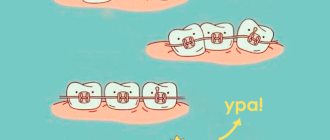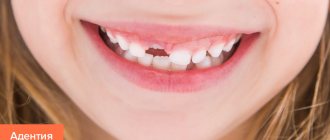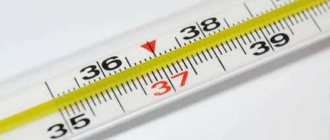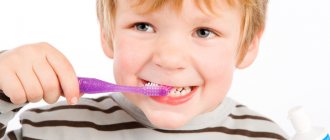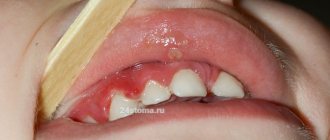What is edentia in children?
Adentia in children is a partial or complete absence of teeth due to their loss or abnormal development of the dental system. The disease is characterized by impaired chewing and speech function due to the lack of integrity of the dentition. In severe cases, dental edentia in children is accompanied by deformation of the facial skeleton and further loss of teeth. In the complete absence of teeth, there is often a displacement of the lower jaw towards the nose, retraction of the soft tissues of the pre-oral area, and the formation of wrinkles. With partial edentia in children, the remaining teeth shift and diverge. And in the process of chewing, an increased load falls on them.
Interesting fact!
The rudiments of baby teeth are formed in babies still in the womb, at about 3-4 months of pregnancy. The process of their formation takes about a month, so it is important that during this period the expectant mother consumes dairy products rich in calcium, without which the full formation and subsequent health of teeth is impossible.
How to save your front baby teeth
The main and main cause of damage to the upper anterior incisors in children at an early age is “bottle caries”. And today it is far from uncommon. Moreover, caries begins at a very early age (sometimes even in infancy) and develops not just quickly, but rapidly. Where does it come from? It's simple: caries develops as a result of night feeding with breast milk, artificial formula, compote or juice. Any sugar-containing liquids literally stick to the teeth, flowing from the side on which the baby sleeps and to the front upper teeth. And since saliva is not produced during sleep, sugar remains on the teeth and begins to destroy the enamel, which leads to caries. To the greatest extent (90% of cases) it affects the upper incisors and chewing teeth. And if the treatment of the latter does not cause any particular difficulties, then there are still many questions, disputes and disagreements regarding the front incisors.
Where does caries begin?
Caries begins with a white spot on the tooth, which most often goes unnoticed if the baby is not shown to the pediatric dentist in time. The “white spots” do not bother the baby himself. However, literally within a few months, carious cavities can become very deep, causing the child quite severe discomfort during meals and even at night.
What happens if you don’t treat your child’s teeth?
It’s simple, a fairly extensive chronic inflammatory process will arise, the frequent companions of which, in addition to dental problems themselves, are loose tonsils and other ENT diseases and even diseases of the gastrointestinal tract. In addition, bone tissue and the rudiments of permanent teeth suffer from chronic infection. And when the process reaches a “critical point,” the matter can end in fluxes and purulent fistulas, which are often accompanied by acute pain and high fever.
"Important" age
Children aged 1.5 to 4 years usually turn to pediatric dentists with similar problems. And often children come with almost destroyed front teeth. Namely, during this period, the front incisors are more important than ever, both from an aesthetic and functional point of view: they bear a fairly high load associated with biting food, especially hard food. In addition, without the front teeth, the bite (subsequently there may not be enough space in the jaw for permanent teeth) and speech (the tongue does not have support, and the child begins to lisp) are formed incorrectly. And of course, like adults, kids worry about the beauty of their smile. If black, dilapidated “stumps” stick out in the mouth instead of beautiful white teeth, children are embarrassed to smile and constantly cover their mouths with their hands.
And by the age of 5, the resorption of the roots of milk teeth will begin, and by 6-7 years, permanent teeth should erupt, the health of which directly depends on the condition of their milk predecessors. That is why you need to take care of the health of your upper incisors as early as possible.
What's the difficulty?
There are several reasons why treating frontal teeth in children is very difficult.
Firstly, only when treating incisors with deep damage to the enamel is the passage of canals mandatory. That is, everything is the same as in adults: you need to drill out the tooth, remove the nerve, take before and after pictures, go through the canal with a special material, and only after that can you put a filling. Therefore, treatment of only one front incisor takes 30-40 minutes!
Secondly, as we said, the main patients with caries of the front teeth are children from 1.5 to 3-4 years old (in 80% of cases these are children aged 2-3 years), so treatment is possible only under general anesthesia. For such a baby, finding contact “with someone else’s aunt” is still, to put it mildly, difficult, and the perseverance is still not enough to withstand such a long time in the dentist’s chair (if only the doctor needs an average of 30-40 minutes for one tooth, and such teeth 4 – so count for yourself).
By the way! It does not happen that one or two teeth are affected by caries, and the rest remain healthy - usually all 4 front incisors are always affected.
Background
It is because of all these difficulties that until recently there were not so many ways to “treat” the upper anterior incisors.
Depending on the degree of damage, the teeth were covered with silver. But since this approach gives absolutely no effect, the carious process soon destroyed them completely, and then the teeth had to be removed. The “side effects” of this method also include the fact that the “silver” makes the teeth turn black and, to put it mildly, does not look aesthetically pleasing, which only adds to the problems.
If the situation allowed, then sometimes it was possible to fill the canals in order to save space in the upper jaw for permanent teeth, and in the place of the former “milk jugs” there remained small “stumps” that were in no way capable of fulfilling their functional tasks, not to mention their appearance.
Another “popular” approach is to leave everything as is for as long as possible. We have already talked about fluxes and temperature. Actually, they became the consequences of such “treatment”. Result? Parents are simply forced to bring their child to the clinic for removal.
By the way! In the absence of teeth, the jaw narrows, and this subsequently negatively affects the bite: there is not enough space for permanent teeth!
True, sometimes with the help of all kinds of rinses and “traditional methods of treatment” at home, this acute process is removed, the baby rinses out the pus and continues to live with bad teeth and a chronic infection in the mouth, from which the bone tissue suffers.
By the way! Until 3 years of age, mineralization of the rudiments of the anterior permanent teeth occurs. And in fact, they are formed under conditions of constant inflammation and chronic infection. This means that the rudiments of permanent teeth do not develop normally: the teeth will be weak, and the enamel will be of uneven color and in some places immature.
What to do if teeth are removed after all
One of the modern solutions to this problem is a replacement plastic plate. However, although it holds the jaw well for permanent teeth, it is otherwise purely aesthetic in nature (outwardly it looks like real teeth), without bearing any chewing load.
The plate can only be installed at the age of 4.5-5 years. The fact is that it requires a conscious attitude on the part of the child. You need to take care of the plate, clean it, remember to take it off and put it on, you need to get used to it, like any other foreign object in the mouth. That is, the baby must understand why he is doing it, and, what is important, want to do it! And it is not always possible to “agree” with a child; it is especially problematic to do this with boys.
In addition, if teeth were removed at 2 years old, then at least until the age of 4 years the baby is forced to live without teeth, which is not physiological. Restoration of anterior teeth as an art of pediatric dentistry
Over the past few years, a number of clinics have begun to restore the anterior incisors. The roots of these teeth are treated, pins are placed, and the crown of the teeth is restored using filling materials. For aesthetic restoration, materials of different colors with corresponding names are used - “dentin”, “enamel”, “incisal edge”, so that the teeth can look as close as possible to their real teeth. Crowns: a modern and effective solution
Fortunately, today there is a solution to the problem of the upper incisors, such as crowns. Crowns are made of a hypoallergenic alloy and lined with zirconium oxide. This is a rigid and durable structure, which, like in adults, is attached to cement and holds the tooth well. In addition, from an aesthetic point of view, crowns look good. And children truly appreciate this: they begin to smile with pleasure without covering their mouth with their hand.
So, how does a crown “work” and help save teeth? The root of a tooth affected by caries is treated, the nerve is removed, and a canal is traversed. If the tooth tissue is preserved, then it is minimally filled; if not, then a pin is installed, and the tooth itself is restored (restored) with filling material. On top, slightly under the gum, crowns are placed, which play the role of protective “caps,” mechanically holding the tooth and helping to preserve the restoration until the teeth are replaced with permanent ones. It is by installing it under the gum that the crown helps protect the restored tooth, which consists of 90% filling material, when bitten off or injured.
Since by the time of treatment there is nothing left of your own tooth, crowns are selected “by eye”: impressions, like for adults, are never made. Based on the size of the roots and adjacent teeth, as well as the structure of the jaw, we can determine what size crowns are needed. However, we always install crowns that are slightly smaller than our real teeth to avoid the teeth not coming together when the child wakes up from anesthesia. Over the next few months, the installed crowns “sit” in the bite due to the plastic childhood periodontium and a number of other physiological features. If, for example, when fixing the crown, the crown was turned out, then when the baby comes for a consultation after 2-3 months, the teeth are in a row. Nature literally helps children. This simply cannot happen to an adult!
By the time the baby teeth are replaced by permanent ones, the roots of the “milk jugs” begin to dissolve. As a result, the crowns fall out along with the pin, and permanent teeth take their place.
Clear benefits
Of course, both of these methods allow you to preserve the front incisors until they are physiologically replaced. It is very important! But let's figure out how the baby feels...
Firstly, after treatment of the roots of the teeth and subsequent restoration, the child begins to eat normally and gains weight: after all, with severely damaged teeth, as we said, contact with food causes discomfort and sometimes even acute pain. Meat, apples, carrots appear in the toddler’s diet - that is, things that he simply could not bite or chew before. Secondly, since nothing bothers the baby (and at the stages of deep caries, children often experience pain at night), he sleeps better. Thirdly, the teeth look very aesthetically pleasing, and now the baby can smile from ear to ear without embarrassment. Tell me, is this not enough?
It's important to remember that...
...installing crowns takes less time than aesthetic restoration of teeth using filling materials. And this, in turn, allows you to reduce the time of anesthesia. In addition, the filling material gains color over time (stained by food and drinks), cracks appear on it, so it must be polished periodically. And lastly: crowns allow for 70% better preservation of teeth, protecting them from injury and mechanical damage during chewing. But the materials used for restoration are not strong enough and often break.
Nevertheless, the method of preserving the front teeth in each case is selected individually, depending on a number of indications and contraindications, the state of the oral cavity, etc. The main thing is that now it has become possible! We are convinced that if it is possible to save a child’s teeth for 2-3 years, ensuring normal chewing and jaw development, then this is a huge achievement and truly “aerobatics” for pediatric dentists.
Types of edentia in children
Edentia in children is divided into types in accordance with the criteria indicated in the table below.
| Criterion | Type of edentia | Characteristic |
Time of occurrence | Primary (congenital) | Absence of baby teeth in young children and permanent teeth in older children |
| Secondary (acquired) | Lost tooth after eruption | |
Number of missing teeth | Partial | Some teeth are missing |
| Full | All teeth are missing | |
Age period | Edentia of temporary occlusion | Appears during the eruption of baby teeth |
| Edentia of permanent dentition | Appears during the period when baby teeth are replaced by permanent teeth. | |
Reason for missing tooth | True edentia | There is not even a tooth germ in the jaw |
| False edentia (retention) | Delayed tooth development. There is free space where the tooth should be, and subsequently it erupts |
When do the first teeth appear?
It is widely believed that a baby's first teeth should appear at six months.
If a child is 8 months old and has no teeth, parents begin to worry. Baby teeth begin to form in utero long before they become visible. Their rudiments appear already in the sixth week after fertilization. Over the next months, gradually, layer by layer, they are covered with hard enamel. A newborn's baby teeth are already formed.
A little later, roots begin to form. As they grow, they slowly push out the top of the tooth, which breaks through the gum. It happens that everything happens so quickly that the child is born with one or two teeth.
Newborn with teeth
The norm of the appearance of the first teeth
Usually, parents begin to look into the baby's mouth in search of the long-awaited tooth when he is 6 months old. Many of them soon find what they are looking for there. The rest patiently continue to carry out daily inspections. When a child turns 7 months old and still has no teeth, this is not a reason to worry. Most parents know this and therefore remain calm.
But when a baby doesn’t have a single tooth at 8 months, there is slight anxiety in the family. After all, everyone knows that from six to the beginning of the ninth month the incisor should appear. But should you? In fact, these norms are based on average statistics and are not a rule. There are cases when children are already born with several teeth, and it happens that the baby’s first incisor pecks only in the 9th or even 12th month of his extrauterine life.
Additional Information. In general, pediatricians advise parents not to panic if a long-awaited event drags on for up to 1.5 or even 2 years. Of course, provided that the rest of the baby develops normally.
Timing of the eruption process
There are average periods for the appearance of teeth, which are the norm.
Important! Each child is individual. It will be normal for a 4-month-old baby to erupt the first teeth and for a 10-month-old baby too.
Average terms:
- At birth, teeth are not visible. They are partially formed, but are located inside the gum;
- The first teeth appear on average between the fourth and seventh months (most often around 6 months of age). First, 4 central incisors emerge, two each below and above;
- At approximately seven or eight months, the 4 lateral incisors emerge;
- When a child is about a year old, his first 4 molars begin to grow. This leaves free space between them and the lateral incisors;
- This space contains 4 canines, which usually emerge at approximately 1 year and 4 months;
- At about 2 years of age, the second molars begin to grow;
- At the age of 3 years, a child should have all 20 baby teeth.
Teething pattern
Important! In children with late teething, they can all come out almost simultaneously.
Number of teeth at 8 months of age
For most children, the appearance of their first tooth becomes a pleasant surprise at the age of six months. Sometimes both lower incisors are shown at once. The upper central incisors erupt next. By the age of 8 months, the baby’s mouth is usually decorated with 4 teeth. And by one year – 8-12 teeth. All milk, namely 20 units, should appear by 3 years.
This is interesting: The drug Dentokind: instructions for use for children up to one year old and after teething
Causes of edentia in children
Edentia in children can be hereditary, but it can also develop during the child’s life. In this regard, there are several causes of dental edentia in children.
- Absence or death of tooth buds.
This may be due to hereditary reasons, as well as disturbances in the formation of the fetus in the womb. A child’s dental plate is formed during the prenatal period, and exposure to harmful factors (for example, poor environment or an unhealthy lifestyle of the mother) can negatively affect this process. - Loss of teeth during life.
Children, especially boys, due to their activity, are more susceptible to injury than adults. Thus, children’s teeth often fall out during fights, falls, and also when playing certain sports (hockey, football, boxing). - Deep caries and its complications.
Due to the thin enamel of baby teeth, caries in children develops on them much faster than on permanent ones. Therefore, if it is not treated in a timely manner, there is a risk of losing the tooth as a result of progressive purulent-inflammatory processes in the tissues.
Why does an 8 month old baby have no teeth? Causes
There are many reasons why a baby may experience delayed teething. It is worth listing the most common ones.
1. Rickets. The occurrence of this disease can provoke a significant delay in teething. If the baby has been diagnosed with rickets, the baby’s parents need to go to a medical institution to conduct the necessary examination, as well as to donate blood to check for the presence of vitamin D in the baby’s body.
2. The presence of disorders in the endocrine system of the body.
3. The absence of teeth, caused by illnesses suffered by the mother during the period of bearing a child, can cause an eight-month-old child to have no teeth and severe disturbances in the order of their appearance.
The formation of the dental apparatus is also influenced by the diet followed by the expectant mother and lifestyle. The course of pregnancy is one of the factors that pediatricians consider when determining the cause of the delay in the appearance of the first teeth.
The delay in the appearance of hard formations in the infant’s oral cavity may be due to genetic characteristics. If close relatives: parents, sisters, brothers, grandparents, first teeth appeared quite late, then the phenomenon of delay is quite understandable.
Treatment of adentia in children
Diagnosis of dental adentia in children is carried out by visual and palpation examination, targeted intraoral radiography and orthopantomography. The treatment tactics for adentia in children are determined taking into account the physiological, anatomical and hygienic characteristics of the child’s dental system. Depending on the degree of the disease, the following methods of treating adentia in children are used.
- Stimulation of teething.
In some cases, a procedure is used to dissect the gums and install special braces that stimulate teething.
- Fixed prosthetics.
The child is fitted with permanent orthopedic structures (crowns, bridges).
- Removable prosthetics.
Removable orthopedic structures (clasp, plate dentures) are installed.
- Dental implantation.
It is used only after the jaw bones are completely formed. This process is usually completed at the age of 18 for boys and at 16-17 years for girls. Until this time, edentulous treatment is carried out using removable and fixed dentures.
How many teeth should an eight month old baby have?
Correct, i.e. normal, development of the baby’s chewing apparatus implies that the baby has the rudiments of 20 milk teeth and 16 molars. By the eighth month of a baby’s life, there may be from two to four teeth in the baby’s mouth. In some cases, the number of solid formations can reach six or even eight.
Teeth eruption is characterized by their paired appearance on the left and right sides of the jaw. Solid formations begin to appear in a certain sequence. However, here, too, some deviations from the norm are possible, due to the characteristic features of the child’s body or genetic characteristics.
Consequences of edentia in children
If you do not consult a specialist in time and do not treat edentia in children, this can lead to deformation of the facial skeleton, which results in developmental defects in the child.
- Speech impairment.
With complete or partial absence of teeth, the child pronounces some sounds incorrectly, and may even lose the ability to pronounce them. - Chewing dysfunction.
Due to a decrease in the quality of chewing food and changes in food consumption patterns, missing teeth often leads to gastrointestinal diseases in a child. - Mental disorders.
Missing teeth is also a cosmetic defect. The baby is embarrassed to smile, and as a result he develops complexes. In addition, disturbances in the functioning of the jaws caused by edentia bring discomfort and cause deterioration in mood.
Prevention of teething disorders in infants
Doctors recommend that women prepare in advance for the desired pregnancy. The expectant mother needs to closely monitor the health of her teeth and the condition of her oral cavity in general. It is useful to take vitamin complexes, as well as eat foods rich in calcium as often as possible.
It is recommended to get rid of bad habits and carefully monitor your health. It would be useful to regularly check the level of hemoglobin in the blood.
After the birth of the long-awaited baby, you need to monitor his proper nutrition, often walk in the fresh air, carry out hardening procedures and regular hygiene.
How much does treatment cost?
Treatment of adentia in children begins with an initial examination and drawing up a treatment plan. Typically, these services are provided free of charge - as a promotion to attract customers. Also, a small patient will need to have an x-ray at a cost of 350 rubles and a panoramic photograph of the oral cavity, the cost of which starts at 1,000 rubles. In addition, before starting treatment of adentia in children, it is necessary to carry out professional oral hygiene at a price of 2,700 rubles and more. Based on the fact that edentia in children is treated primarily by installing removable dentures, parents should be prepared for the following costs for various types of orthopedic structures: a partially removable laminar denture costs from 1,750 to 60,000 rubles, a complete removable laminar denture costs from 40,000 to 100,000 rubles, temporary complete removable denture - from 2,800 to 3,500 rubles. A removable acrylic prosthesis will cost from 12,000 rubles, a bridge prosthesis - from 25,000 rubles. The cost usually includes the manufacture of the structure and its installation by a specialist.
Content
- Types of appetite disorders
- Prevention of appetite disorders in children
- Causes
- Consequences of long-term eating disorders
- Treatment
Appetite performs a regulatory function in the body, signaling the need to replenish nutrients. Appetite is associated with the work of the food center, which is located in the hypothalamus and cerebral cortex. It is in these areas that food-related impulses are processed and where satiety signals come from. One of the factors that causes the desire to eat is also changes in blood sugar levels. Source: Your Child's Health. The latest reference book./Under the rivers. V.A.Alexandrova. Eksmo Publishing House, 2003
Choosing a brush and toothpaste for your baby
How to choose a toothbrush
Conventional, electric or ultrasonic? Soft or hard? Synthetic or natural? Accurate answers to all questions.
A baby toothbrush looks like this.
It has a short working part - from 18 to 25 mm. Until the age of five, a child has a brush with very soft (extra soft) synthetic bristles, and from a later age - with soft bristles with rounded ends. The handle of the children's brush is thicker, with non-slip inserts - this makes it easier for the baby to hold it. Children's toothpastes
are also different from adults. They are low in abrasives, low in fluoride, and contain fruity fragrances and flavors. Look carefully at what age of children this or that toothpaste is intended for.
Consequences of long-term eating disorders
As already mentioned, long-term deviations in eating behavior can lead to either obesity or dystrophy, that is, depletion of the body. Consequences may also be:
- sleep disorders;
- decreased immunity due to lack of nutrients necessary for the body;
- the appearance of cracks or stretch marks on the skin (with rapid growth of adipose tissue);
- disruption of the activity of internal organs; Source: E.V. Pavlovskaya Selective appetite in children // Issues of modern pediatrics / 2013/ Volume 12/ No. 6
- depression of brain activity (decreased memory and speed of thinking).
What parents need to remember
The baby should see the dentist for the first time at six months, and the first tooth should be cleaned with a special brush.
Sweets harm the first teeth, but daily brushing with a special children's brush and toothpaste is beneficial. Tags:
- Hygiene
- Teeth
- Preschoolers
- Babies
- Kuzmina
3 comments • To leave a comment you must be an authorized user
- few Hello everyone. I wanted to recommend a cool service to you. Using this service, you can find out for free on your phone. You can also read reviews about the numbers or leave your own if a scammer calls you. Thank you for reading my post. I create useful services for people. https://kto-zvonil.net https://kto-zvonil.net https://kto-zvonil.net https://kto-zvonil.net https://kto-zvonil.net https://kto -zvonil.net https://kto-zvonil.net https://kto-zvonil.net https://kto-zvonil.net https://kto-zvonil.net
- tancuet massage "methods: gently massage the gums"
- irina_golovleva at 6-8 months a child can be given hard cheese, gooseberries, currants, cherries???????!!!!!!!!!!!!!!!!!!!!!!!!!!! !!!


